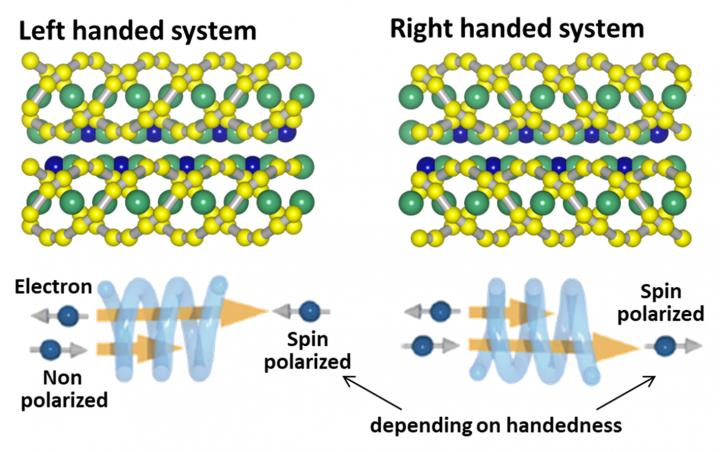Apr 22 2020
In the mirror, a left hand resembles a right hand, but it can never overlap with the right hand. This geometrical relationship in which the image of an object in a plane mirror cannot coincide with itself is known as chirality.
 Schematics of crystalline structures of chiral crystals CrNb3S6 and spin-polarization phenomena in chiral materials. A tiny helical structure at atomic scale generates spin-polarized current (electron flow). Image Credit: NINS/IMS.
Schematics of crystalline structures of chiral crystals CrNb3S6 and spin-polarization phenomena in chiral materials. A tiny helical structure at atomic scale generates spin-polarized current (electron flow). Image Credit: NINS/IMS.
An example of a chiral structure is a clockwise or counterclockwise helical staircase. By contrast, a round ball is not chiral as its image in a mirror coincides well with the original shape.
The structure of a material that is composed of atoms and/or molecules may show chirality. Chiral crystals or chiral molecules are known to exhibit a chiral structure, for example, amino acids, deoxyribonucleic acid (DNA), and sugars. Although such chiral substances are vital to living activity, their electrical and magnetic characteristics have not garnered much interest to date.
Ron Naaman and colleagues Israel recently discovered that of spins of electrons orient in the same direction when they pass through chiral molecules like DNA. Since the spin direction depends on a chiral molecule structure’s handedness, this phenomenon is termed chirality-induced spin selectivity (CISS).
CISS studies confirmed that non-magnetic chiral molecules render electron spin-polarized. This phenomenon is highly perplexing and its mechanism has not yet been verified. Creating a spin-polarized state in a non-magnetic material is a crucial research goal to advance next-generation electronics and quantum science. It is highly intriguing to study the universality of the spin-polarized phenomena in chiral materials extensively found in crystals and molecules.
As part of this study, scientists from Osaka Prefecture University, Institute for Molecular Science, The Open University of Japan, and Toho University studied a “chiral crystal” instead of a chiral molecule. This crystal includes a helical arrangement of atoms that twist in a single direction.
A helical structure such as that can be observed all over the chiral crystal. Molecules are extremely small, invisible entities, but crystals are sufficiently large to be handled. In general, crystals also show material stability and fabrication feasibility.
CrNb3S6—the chiral crystal used in this study—is a metal with good electrical conductivity but no magnetism at room temperature when there is no magnetic field. But the experiments showed that electrons that flow in CrNb3S6 are spin-polarized. Specifically, the chiral crystal makes the spins of electrons that flow to aligned in the same direction instantaneously.
When an electrical current is applied to the coil used in day-to-day appliances, magnetic fields are induced in the coil. This acts as a macroscopic electromagnet that produces macroscopic magnetic fields. A helical configuration of atoms discovered in the crystals generates polarized spins. That is, it acts as a “microscopic” electromagnet that produces polarized spin in the microscopic tiny world.
This study confirmed that spin-polarized phenomena discovered originally in chiral molecules emerge even in chiral solid crystals. This indicates that such phenomena universally occur in an extensive array of chiral materials, ranging from chiral molecules to chiral crystals. The research contributed fundamentally and crucially to the field of spin manipulation and detection along with chiral systems.